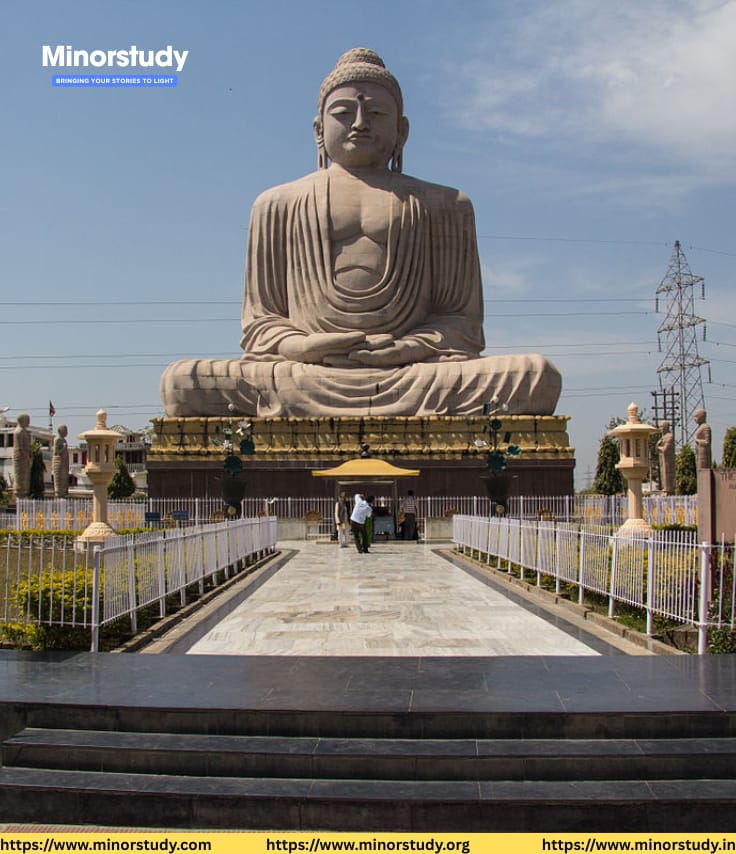🌟 Introduction: The Sacred Soil Where Enlightenment Bloomed
In the heart of India lies Bodh Gaya, a quiet town in the state of Bihar that changed the course of human history. It’s not just a destination — it’s the birthplace of Enlightenment. Here, under the sacred Bodhi Tree, Siddhartha Gautama attained Buddhahood, becoming the Buddha, the “Awakened One”.
- 📜 History of Bodh Gaya: From Prince to Buddha
- 📚 7 Powerful Facts About Bodh Gaya You Must Know
- 📆 Timeline: Bodh Gaya Through the Ages
- ❓ FAQs About Bodh Gaya
- 🧘 Q1: Why is Bodh Gaya important?
- 🌍 Q2: Who visits Bodh Gaya?
- 🛕 Q3: What is the Mahabodhi Temple?
- 📅 Q4: What is the best time to visit Bodh Gaya?
- 🎇 Observance & Celebrations
- 🌈 Wishing Message
- 📌 Important Points to Remember
- ❤️ Importance in Daily Life
- 🏛️ Significance in Society
- 🌐 1. Global Spiritual Hub
- 🧘♀️ 2. Center for Meditation and Yoga
- 🧑🎓 3. Educational Legacy
- 🏞️ 4. Eco-Spiritual Awareness
- 🧾 Conclusion: Bodh Gaya – A Light for the Ages
People from around the world — seekers, pilgrims, scholars, and curious travelers — walk the same soil, hoping to absorb a fraction of the peace and insight that bloomed here 2,500 years ago.
Let us take a journey through the history, spiritual power, global impact, significance, and enduring legacy of Bodh Gaya.
📜 History of Bodh Gaya: From Prince to Buddha
The story of Bodh Gaya begins over 2,500 years ago, in the 6th century BCE.
Siddhartha Gautama, a prince from the Shakya clan, left his palace in search of truth. After years of spiritual practice and asceticism, he arrived at a place near the Niranjana (Phalgu) River, sat under a peepal tree, and meditated deeply.
It was here that he finally transcended worldly illusions and attained enlightenment, becoming the Buddha. This sacred site became known as Bodh Gaya, meaning “the place of awakening.”
🏛️ Historical Milestones
| Year | Event |
|---|---|
| 6th century BCE | Enlightenment of Gautama Buddha under Bodhi Tree |
| 3rd century BCE | Emperor Ashoka visits Bodh Gaya, builds Mahabodhi Temple |
| 11th–13th century | Flourishes under Pala and Gupta empires |
| 19th century | Burmese and Sri Lankan Buddhists begin restoration |
| 2002 | Mahabodhi Temple declared a UNESCO World Heritage Site |
📚 7 Powerful Facts About Bodh Gaya You Must Know
🌳 The Bodhi Tree is a descendant of the original — replanted from a sapling taken to Sri Lanka by Emperor Ashoka’s daughter, Sanghamitra.
🕍 The Mahabodhi Temple is one of the oldest brick structures in India — built in the 3rd century BCE.
🌍 Pilgrims from over 50 countries visit annually, making it one of the most internationally revered Buddhist sites.
🧎♀️ Thousands of monks chant here daily, especially during Buddha Purnima.
📿 The temple complex houses a Vajrasana (Diamond Throne) — the spot where Buddha sat while attaining enlightenment.
🧭 It’s part of the Buddhist pilgrimage circuit along with Sarnath, Kushinagar, and Lumbini.
🕊️ Despite being in India, Bodh Gaya holds global significance for over 500 million Buddhists worldwide.
📆 Timeline: Bodh Gaya Through the Ages
| Period | Significance |
|---|---|
| 6th Century BCE | Siddhartha becomes Buddha |
| 3rd Century BCE | Ashoka constructs shrines, spreads Buddhism worldwide |
| 7th Century CE | Xuanzang visits Bodh Gaya |
| 11th–13th Century | Flourishes with universities like Nalanda nearby |
| Colonial Era | Decline due to invasions and neglect |
| 20th Century | Revival by Mahabodhi Society and Buddhist nations |
| 2002 | UNESCO World Heritage status |
❓ FAQs About Bodh Gaya
🧘 Q1: Why is Bodh Gaya important?
Because it is the exact location where Gautama Buddha attained enlightenment under the Bodhi Tree, making it the most sacred Buddhist site in the world.
🌍 Q2: Who visits Bodh Gaya?
Buddhists from Sri Lanka, Japan, Thailand, Myanmar, Tibet, Bhutan, China
Spiritual seekers and tourists from all over the world
History lovers and archaeologists
🛕 Q3: What is the Mahabodhi Temple?
A UNESCO World Heritage Site, the Mahabodhi Temple is a towering structure with intricate carvings, believed to stand on the original spot of Buddha’s meditation. It is surrounded by smaller stupas, the Bodhi Tree, and monastic complexes from various nations.
📅 Q4: What is the best time to visit Bodh Gaya?
The best time is during October to March. Buddha Purnima (May) is the most celebrated day, marking the Buddha’s birth, enlightenment, and Nirvana.
🎇 Observance & Celebrations
| Occasion | Description |
|---|---|
| Buddha Purnima | Grand annual celebration of Buddha’s birth, enlightenment & Nirvana |
| International Sangha Gatherings | Global Buddhist monks unite for meditation and teachings |
| Kathina Ceremony | Buddhist robe offering ceremony by Theravada monks |
| Full Moon Meditations | Commonly observed nights for spiritual observance |
🌈 Wishing Message
🪷 May the wisdom and peace that radiate from Bodh Gaya inspire our hearts and minds. May we all find our own Bodhi Tree — a place of clarity, compassion, and calm. Om Mani Padme Hum. 🙏
📌 Important Points to Remember
It’s not just a place for Buddhists — seekers from all religions find peace here.
Bodh Gaya influences global Buddhism, from Southeast Asia to the West.
Symbol of universal peace and non-violence, especially in today’s world of conflict.
Major spiritual tourism hub that benefits local communities economically.
❤️ Importance in Daily Life
Bodh Gaya may seem like an ancient, distant land, but its teachings are deeply relevant today:
1. Mindfulness
The Buddha’s teachings on awareness and self-control began here. Today, mindfulness meditation is used globally for mental health.
2. Compassion and Peace
In a divided world, the messages from this sacred site serve as reminders of unity and empathy.
3. Pilgrimage and Humility
Walking through Bodh Gaya reminds us of the power of silence, discipline, and simplicity.
🏛️ Significance in Society
🌐 1. Global Spiritual Hub
Bodh Gaya connects India to Sri Lanka, Thailand, China, Korea, Japan, and beyond, making it a universal spiritual heritage site.
🧘♀️ 2. Center for Meditation and Yoga
People visit from around the world to attend Vipassana retreats and Buddhist discourses.
🧑🎓 3. Educational Legacy
Bodh Gaya, along with Nalanda and Vikramshila nearby, formed the intellectual spine of ancient India’s knowledge system.
🏞️ 4. Eco-Spiritual Awareness
Surroundings are protected, and green tourism is encouraged. Spirituality here aligns with sustainability.
🧾 Conclusion: Bodh Gaya – A Light for the Ages
Bodh Gaya is more than a physical location — it’s a living symbol of human potential. What began as a personal journey for one man has now become a beacon of hope for millions.
Its teachings of peace, patience, self-realization, and compassion are timeless truths that guide not just Buddhists but humanity at large. Whether you’re a spiritual pilgrim or a curious traveler, Bodh Gaya speaks to the soul.
In a world searching for balance, Bodh Gaya reminds us that stillness can be powerful, that peace can be profound, and that every one of us holds the potential to awaken.








